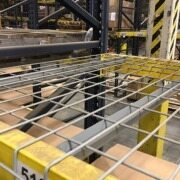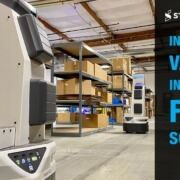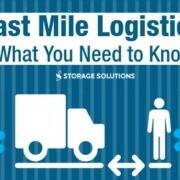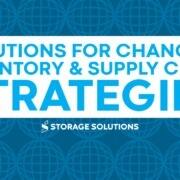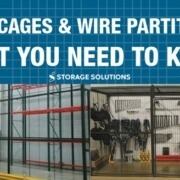Order fulfillment in today’s world is significantly different from even just a few years ago. With the rise of e-commerce, expectations for order fulfillment’s speed and accuracy make it hard for traditional warehouse operators to keep up.
In competing with the Amazons of the world, these traditional distribution centers are battling against now-slow fulfillment times, rising labor costs, and throughput challenges. Meeting those customer demands can be trying without introducing technology and dynamic solutions designed to meet those challenges head-on.
For those new to these emerging technologies, making that jump into automation can be scary. However, Fetch Robotics offers a line of products designed to assist with several operational variations without massive infrastructure investment.
They may not fully understand that there are introductory-level solutions available that allow incrementally beneficial solutions, many of which offer a return on investment relatively quickly. Plus, you do not have to deal with software integration or making a bunch of infrastructure changes. Instead, you can get a simple solution up and running quickly and easily. If you need something complicated or need a more comprehensive solution over time, these solutions can be more fully integrated to meet those needs.
Here are five ways that Fetch can incrementally add value to your operations:
- Zone Pick/Batch Picking: Autonomous mobile robots (AMRs) are great tools to handle material movement, especially in zone or batch picking scenarios. They can physically move products from the pick area to another point in the process – perhaps to a conveyor or packing area. This usage saves your labor force from the physical toll of handling the material and traveling required, which also cuts down on travel time and allows your fulfillment to happen quicker.
- Each Picking / Case Picking: People typically do not think of AMRs when handling each pick or case pick scenarios. However, that is a misconception. In fact, with the rise of e-commerce, these AMRs can similarly speed up the fulfillment process. Because each picking tends to associate itself with higher labor costs, integrating AMRs can be a great way to keep those labor costs down by reducing the distance traveled and the wear-and-tear on your workers.
- Adaptability: As consumer demand continues to change, distribution centers that rely on heavy-duty pick modules or conveyors can fall behind. Why? Because they cannot change their processes quickly enough to meet those changes, the infrastructure they have constructed is too limiting and costly to move. Fetch Solutions allow your operations to quickly and easily adjust as needed.
- Scalability: With a Fetch AMR solution, you can scale your automation quickly and simply by adding robots. Because workflows are developed within the FetchCore cloud operating platform, they can be programmed within just a few minutes. By adding more robots, you can increase your throughput as needed, allowing you to respond to demand changes as quickly as you need to.
- Flexibility: Because these AMRs run on cloud-based software, they can be re-programmed at any point from anywhere that has an internet connection. That means, should your needs change – for instance, a new pick point needs to be added or removed, you can set those points without needing to re-program or re-map an entire facility.
Let’s Talk this Through
These solutions are not solely limited to support e-commerce, either. AMRs can support a wide variety of material handling needs and distribution concepts. Their adaptability, scalability, and flexibility can be explicitly designed to suit any number of needs.
If this is all new to you, know that we are here to help. Our team has years of experience in integrating these systems to fit a variety of industry models. Give us a call today, and we can talk about what challenges you face and determine the right course of action to give your organization that incremental value needed when you are first integrating dynamic solutions.
Did you know that e-commerce return rates comprise 20% of total orders? Did you know that 84% of shoppers are unlikely to purchase again after a bad experience with an e-commerce company? Did you know that the final stage of delivery of a product makes up 53% of total shipping costs?
As changes in consumer demand continue to accelerate, warehouses and distribution centers are looking at how they can handle quicker order processing and faster delivery, especially in the area of last-mile logistics.
For the uninitiated, last-mile logistics – also known as last-mile delivery – is a supply chain industry term that examines how a product travels from a distribution center to its final destination, typically a consumer. To meet the changing demands of consumers, the goal of last-mile logistics is to transport an item in the quickest way possible. However, this stage is often the costliest in the fulfillment process.
What Challenges are Seen in Last Mile Logistics?
The challenges that need to be overcome in last-mile logistics are typically associated with cost, timeliness, and customer satisfaction. Deliveries that feature more stops lead to more time spent before the product gets to the end-user. Urban areas do not offer the speed and fuel efficiency that interstates do, so costs add up. Also, product returns lead to higher operating costs and lower profit margins – whether those are built into a product’s prices or not generally depends on the type of industry from which the product is ordered.
What is the Typical Response to Improving Last Mile Logistics?
In response, warehouses and distribution centers turn to micro-fulfillment centers, typically closer to urban areas, to cut down on the time and cost of delivery. We break down how micro-fulfillment centers help companies meet these new expectations here in greater detail. However, the general idea is to supply these centers will a high volume of similar, regularly ordered products.
Typically, these products are small, relatively inexpensive items such as headphones, apparel, and other goods you may see at lower prices from e-commerce retailers. Because they have such a high volume of orders, these items are stored closer to the consumer. Without micro-fulfillment facilities, these items are stored in large warehouses that were previously designed to fulfill larger orders.
Changing the Way Facilities Support Staging
To facilitate a quicker delivery, more and more we are seeing independent delivery drivers with a lesser dependence on the big shipping organizations like FedEx, UPS, or the USPS. This shift in staging necessitates a change in outbound flow systems. Because companies are using these contracted drivers, the equipment and fulfillment processes within facilities require different methods to get the packages to the independent, often-smaller delivery vehicles, which then gets the product to the end-user quicker. Companies using this newer model allows more organizations to keep up with the e-commerce giants of the world and facilitates a modern delivery method.
Why Use Micro-Fulfillment Centers?
When those smaller, single item orders are placed in a more massive warehouse, the fulfillment process takes longer and is more expensive. The products are further away from masses of population in these transportation hubs, but they also become burdensome to pick because the opportunity cost of picking these items becomes too high. For instance, an employee could pick a single pair of headphones in a similar amount of time that the warehouse could fulfill an order for an entire pallet of products. The value proposition becomes clear: micro-fulfillment centers are smaller, more cost-effective, and offer quicker turnarounds than their big-box warehouse counterparts.
How Can We Help?
To cut down on the cost and time spent on fulfilling orders, companies are setting up these micro-fulfillment centers at an increasing rate. Some companies are even converting abandoned retail stores to serve in this capacity. As they are being built or adapted, they are developed with a high level of technology & automation. While that is certainly a viable option, it can be more expensive than what the new facility truly needs. Through a combination of dynamic, technological, and storage solutions, these centers can be built at a fraction of the cost that one may see, compared to a fully automated facility.
We have years of experience working with our clients in finding the right mix of storage, dynamic & technology solutions to suit their needs now, with the capacity and flexibility to grow in the future. Storage Solutions can work with you to turn these complex logistical conundrums into profitable decisions that can help your company save resources and stay focused as you transition into these micro-fulfillment centers.
Consumer demand is not slowing, and neither is the competition. To meet needs, it is essential to stay up to date with the latest trends and solutions being developed to support changes in the supply chain. With Storage Solutions, you have a helping hand to guide you to ensure your decisions are simple, smart, and strategic for your organization.
If 2020 has offered us one lesson, it would have to be that the only certainty we can count on is uncertainty. This lesson is especially true in the supply chain industry. Between the COVID-19 crisis, changing attitudes toward China, wildfires, and the meteoric rise of e-commerce, the organizations within the supply chain have been tasked with reacting to many changes.
These disruptions caused a shortage of supply in product availability, leading to warehouses being emptier than usual. Other companies – mainly retailers – shut down altogether. However, they already had inventory on the way, which caused a spike in stock within distribution centers.
2020 was a wake-up call for the supply chain industry.
Indeed, there were changes happening already, including the rise of e-commerce. Many companies were heading down the e-commerce path; however, there seemingly was time for companies to adapt to new products, practices, and processes that could allow themselves to continue operating in suboptimal methods. However, the pandemic threw gas on the fire, so to speak, and caused everyone to react quickly to another new challenge.
The companies who survived and thrived during this tumultuous year had previously adopted solutions geared around being flexible and adaptable to changes. There was less of a learning curve because they were already positioned to make nimble changes in their operations.
Near-Shoring
One major step companies are taking to adapt to the “new normal” of the supply chain is near-shoring or sourcing goods closer to the sale point. According to The Innovation Enterprise, 32% of North American and European manufacturing and distribution companies either have or are about to near-shore, with 48% of companies saying they plan to within the next three years.
They cite the reduced shipping time and cost, along with an increased response time as the primary reason to take this step – two direct benefits associated with adjusting operations to meet consumers’ changing expectations.
Adding Safety Stock Inventory
In response to not having enough of particular products with a surge in demand, companies are changing their inventory strategies on safety stock. This change is especially real for necessary products – think of how toilet paper was in high demand during the pandemic outset.
If the supply chain is disrupted, companies need to be able to continue operating in response.
Each company and each industry will have its own calculations of what that safety stock needs to be according to its own order volume and replenishment frequency. However, we are hearing those calculations are changing rapidly to accommodate potential future disruptions.
Increasing Storage Density
To go hand in hand with the increase in safety stock goes an increase in storage density. With these recent changes in supply chain strategies, how much you store, and what you are storing may look different. Products with high order volumes or products that need to get to customers quickly are being stored at higher reserve storage levels. Warehouses are being tasked with increasing storage without increasing their footprint, and high-density storage options like pushback racking or pallet flow racks are ideal solutions in many settings.
Optimization of Pick Processes
In alignment with the acceleration of e-commerce, companies are looking at how they are handling pick processes. More than ever, the entire process is being evaluated, from the design and layout of a facility to the level of automation throughout the facility. Ultimately, warehouses will be holding more SKUs in inventory as SKU proliferation continues in many organizations. This development requires that a facility is optimized for storage and material flow.
We are also seeing more facilities adopt forward pick strategies – such as pick modules – to improve fulfillment speeds. More now than before, there will be some type of automation involved at this point as well, including autonomous mobile robots picking on the ground level, with storage above.
What’s Next?
The companies who need help the most are doing everything from storing products in trailers on their property to using the space designed for forklifts for storage – some are even storing products on their docks. They are struggling to pick and ship efficiently, causing customer service disruptions. These challenges cause labor costs – including overtime – to rise as a percentage of their sales.
One of the things we have learned over the last six months is that there will always be disruptions. Whether those disruptions come in the form of global pandemics, fires, or natural disasters, we know the best action an organization can take is to get ahead and be prepared. We can help. Give us a call – we would love to learn about the challenges your business is seeing and pair them with solutions that help them be nimble, flexible, and ready to adapt as the next new challenge arises.
Wire cages and wire partitions are common solutions for warehouses and distribution centers in which something needs to be protected, or access needs to be restricted. They are great for several uses within a facility and can essentially be constructed to fit any need you may have to keep individuals away from an area or keep something within a space.
These are simple, cost-effective solutions that offer operations managers additional controls over valuable products or infrastructure and keep employees safe by restricting access to areas of your facility to only the individuals who need to be in that area.
Common Uses for Wire Cages & Wire Partitions:
- Tool/Storage Cages: Keep your expensive or specialty tools away from those who do not need to use them with restricted access.
- Driver/Building Access Cages: Keep unnecessary people from traveling the floor of your facility by limiting access at public-facing doors.
- DEA Cages: The United States Drug Enforcement Administration (DEA) has specific requirements that need to be met to physically secure Schedule III – V controlled substances. These cages are ideal for pharmaceutical and medical companies, legal drug warehouses, and more.
- Server Cages: Protect your information technology equipment like servers, routers, and more away from potential damage or accidents.
These products are incredibly popular because of the ease of installation – cages can typically be installed at a lower cost and quicker than other area restriction methods. Additionally, these products can be adapted to fit whatever need you may see. For example, custom colors are often available, custom locks can be added to your cages, and adjustable panels or doors can also be constructed if there is a need within your business.
Need to Know More About Wire Cages & Wire Partitions?
Our team of experts has decades of experience in outfitting warehouses and distribution centers of all sizes with wire cages. We know how these products can be customized to fit the needs of your operations. Give us a call today, and we would be happy to connect you with the appropriate solutions for your facility for today’s needs and beyond.

